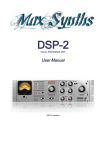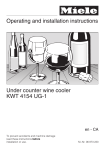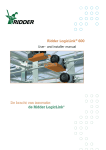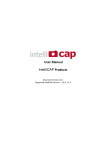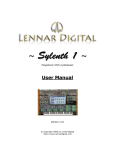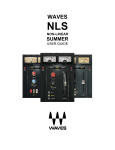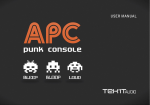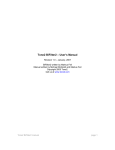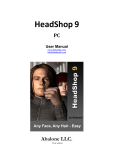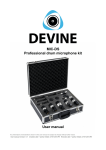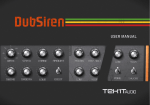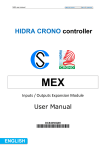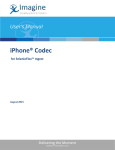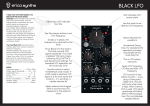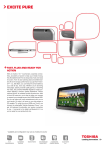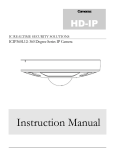Download - MaxSynths
Transcript
DR-910 DRUM MACHINE User Manual - DR-910 Interface - TABLE OF CONTENTS Introduction.............................................................................................................. 3 Features, System Requirements, Installation.......................................................... 4 Signal Flow.............................................................................................................. 5 User Interface.......................................................................................................... 6 INDIVIDUAL INSTRUMENTS KNOBS..................................................................... 7 OTHER CONTROLS........................................................................................... 8 FX Section............................................................................................................... 9 MIDI Note Assignment............................................................................................. 11 MIDI Controllers....................................................................................................... 12 BCR-2000 Configuration.......................................................................................... 13 End User License Agreement.................................................................................. 14 Credits, Contact....................................................................................................... 16 Introduction Welcome and thank you for purchasing MaxSynths' DR-910! DR-910 is a drum machine inspired by one of the most known percussive instruments that massively helped to define the sound of modern electronic music. The instrument itself does not need presentations: used by artists like Moby, Fatboy Slim, The Prodigy, Jean Michel Jarre, The Chemical Brothers, Faithless and many many others, the TR-909 quickly became one of the most classic pieces of gear in the electronic musician's arsenal. In terms of sound the DR-910 VSTi is a faithful reproduction of the original device: each sound section (bassdrum, snare drum, etc.) has been developed to sound and act as similar as possible to the original instrument. The plugin includes also some extra features not available in the hardware version: a reverb unit with independent send controls for each sound source, a compressor tailored to work with drum sounds (based on the same engine of MaxSynths DSP-1) and a Lo-Fi FX processor. These extra features will help the user to quickly shape the sound as desired without using external plugins. However if you need to process the signal with external effects, each drum module signal can be routed to four different stereo outputs that can be independently processed in the DAW. The plugin workflow is straightforward, by the way I suggest you to take a few minutes to read this manual to better understand the instrument in all its parts. I sincerely hope that DR-910 can be a source of entertainment and inspiration for your musical creations. Have fun! Features • Faithful emulation of the original sound • Four stereo outputs • Mute and pan options for each instrument • Independent send level to the built-in reverb unit for each instrument • Built-in compressor featuring IDP cicrcuit * • Built-in reverb unit routable to output 1-4 • Lo-Fi FX with three independent modes • Full MIDI support through MIDI CC# • Behringer BCR-2000 custom template • Easy to operate • Low CPU usage * The same available on DSP-1 Drums VST. System Requirements MINIMUM SYSTEM REQUIRIMENTS: PC running WinXP, Vista or W7, CPU 1Ghz with SSE2 support, 512MB RAM, soundcard with ASIO drivers, compatible ASIO host. Installation 1. Close your host (Cubase, Sonar, etc.). 2. Copy the content of the the zip archive into your VST plugins folder (for example: "C:\Program Files\VSTPlugins"). Be sure to copy both the dll file and the "DSP-3" folder. 3. Run your host and do a plugin rescan (refer to your DAW manual). Signal Flow - DR-910 signal flow - DR-910 features 4 independent stereo outputs. Each instrument (bassdrum, snare, toms, etc.) can be routed to a different output according with your needs. For example is possible to group the toms together to OUT-2, the cymbals to OUT-3 etc; in this way it's possible to process the different percussive sections with different effects from inside your DAW, or you can choose to to use the internal effects for some instruments and process some others with external effects. As indicated in the signal flow scheme above the Lo-Fi FX and the compressor are placed in serial order and routed to OUT-1. The output of the reverb unit, however, can be routed to each of the four available outputs and works in parallel with the Lo-Fi and compressor. This is useful if you need to print the dry and wet sound on different tracks, for example. The output signal of the reverb is sent straight to the selected output destination and is not processed by the Lo-Fi and/or compressor unit (if OUT-1 is selected the reverb is placed after the compressor unit). Please note: the Lo-Fi and compressor are available only on the OUT-1 chain; on other output destinations the signal is sent out dry. This means that if you shape your sound, using for example the compressor, and in a second moment decide to route the snare drum to a different output, this will result in a dramatic change in terms of sound (and also in terms of volume) because the audio material feeded into the compressor has changed. In order to achieve the best results try to remember the signal flow and, if possible, decide in advance how to organize your routing options. User Interface The user interface is divided in two sections. The top part contains the instruments and the lower part the effect section and the main controls. - Instruments section - The instruments section contains the parameters for the different available sounds: – Bass Drum – Snare Drum – Low Tom – Mid Tom – Hi Tom – Rim Shot / Clap * – Hi Hat (closed / open) * – Cymbal (crash /ride) * *coupled In the lower part of the instruments section there are the controls for pan position, output selection (see the Signal Flow chapter for more informations) and reverb send. The instruments which are coupled on the same slot share the same panpot, output and reverb send parameters (rim shot/clap, open/closed hihat, crash/ride). Individual instruments knobs: BASS DRUM: • • • • TUNE: set the instrument intonation LEVEL: instrument volume ATTACK: set the initial click sound DECAY: set the decay time of the amplitude envelope SNARE DRUM: • • • • TUNE: set the instrument intonation LEVEL: instrument volume TONE: noise release time SNAPPY: noise level amplitude LOW, MID, HI TOM: • • • TUNE: set the instrument intonation LEVEL: instrument volume DECAY: set the decay time of the amplitude envelope RIM SHOT, CLAP: • • LEVEL (left): rim shot volume LEVEL (right): hand clap volume HI HAT: • • • LEVEL: closed (CH) and open (OH) hihat volume (coupled) CH DECAY: set the decay time of the amplitude envelope OH DECAY: set the decay time of the amplitude envelope CYMBAL: • • • • LEVEL (left): crash volume LEVEL (right): ride volume CRASH TUNE: set the instrument intonation RIDE TUNE: set the instrument intonation OTHER CONTROLS: Each instrument slot have a red LED which become brigher when the sound is triggered. Clicking on this LED turns off (MUTE) the instrument. PAN: set the panpot position for the slot OUTPUT: set the slot output destination REV: send level to the reverb FX DOUBLE CLICK: reset a knob or slider to its default position. GLOBAL OPTIONS: MIDI CH: select the MIDI receiving channel. VOLUME: set the volume for output 1 (do not affect the output of out 2, 3 and 4). PATCH BROWSER: click the display to open the popup menu or use the PREV and NEXT button to select the patches. LICENSE: show license information. FX Section The FX section feature a reverb, a Lo-Fi unit and a compressor. The Lo-Fi FX and the compressor are connected in serial mode one after the other. The reverb unit works in parallel mode (see the signal flow chapter). REVERB: CONTROLS: PRESET SELECTION: there are eight different presets that can be selected by pressing the corresponding button. OUTPUT: stereo output destination for the wet signal. COMPRESSOR: CONTROLS: ON / OFF: turns the compressor on/off THRESHOLD: set the threshold level MODEL: the compressor can work in two modes, soft and hard. In hard mode the compression ratio level is increased resulting in a more incisive compression effect. MODE: there are two operative modes, normal and parallel. In parallel mode the dry signal is sent to the output together with the signal processed by the compressor. WARNING: selecting parallel mode will result in a massive increment of the volume. LO-FI: The Lo-Fi effect can be used to degrade the sound. This can be useful for experimental purposes or musical styles like hardcore, dubstep, etc. CONTROLS: MODE: select between three diferent modes, 8, 6 or 4bit depending on the degree of intensity desired. MIDI Note Assignment BassDrum: B0-C1 Snare Drum: D1-E1 Tom Low: G1-A1 Tom Mid: B1-C2 Tom Hi: D2 Rim Shot: C#1 Clap: D#1 Closed HiHat: G#1 Open HiHat: A#1 Crash: C#2 Ride: D#2 MIDI Controllers CC#007 Main Volume CC#029 Rim Shot LEVEL CC#012 Bass Drum TUNE CC#065 Rim Shot MUTE CC#013 Bass Drum LEVEL CC#030 Clap LEVEL CC#014 Bass Drum ATTACK CC#066 Clap MUTE CC#015 Bass Drum DECAY CC#048 RS/CL PAN CC#072 Bass Drum PAN CC#049 RS/CL REVERB SEND CC#039 Bass Drum REVERB SEND CC#031 Hi Hat LEVEL CC#060 Bass Drum MUTE CC#032 Closed HH DECAY CC#016 Snare Drum TUNE CC#067 Closed HH MUTE CC#017 Snare Drum LEVEL CC#033 Open HH DECAY CC#018 Snare Drum TONE CC#068 Open HH MUTE CC#019 Snare Drum SNAPPY CC#050 Hi Hat PAN CC#040 Snare Drum PAN CC#051 Hi Hat REVERB SEND CC#041 Snare Drum REVERB SEND CC#034 Crash LEVEL CC#061 Snare Drum MUTE CC#036 Crash TUNE CC#020 Low Tom TUNE CC#069 Crash MUTE CC#021 Low Tom LEVEL CC#035 Ride LEVEL CC#022 Low Tom DECAY CC#037 Ride TUNE CC#042 Low Tom PAN CC#070 Ride MUTE CC#043 Low Tom REVERB SEND CC#052 Cymbal PAN CC#062 Low Tom MUTE CC#053 Cymbal REVERB SEND CC#024 Mid Tom LEVEL CC#054 Compresson ON/OFF CC#025 Mid Tom DECAY CC#055 Compressor THRESHOLD CC#044 Mid Tom PAN CC#056 Compressor MODEL CC#045 Mid Tom REVERB SEND CC#057 Compressor MODE CC#063 Mid Tom MUTE CC#058 Lo-Fi ON/OFF CC#026 Hi Tom TUNE CC#059 Lo-Fi MODE CC#023 Mid Tom TUNE CC#027 Hi Tom LEVEL CC#028 Hi Tom DECAY CC#046 Hi Tom PAN CC#047 Hi Tom REVERB SEND CC#071 Hi Tom MUTE BCR-2000 Configuration The configuration file provided allows to control the key parameters with a Behringer BCR-2000 controller. To load the sysex file into your BCR-2000 follow these INSTRUCTIONS: 1) Turn on the BCR-2000 and select an empty preset slot. 2) Run your host or the program you use to transfer the sysex files and load the BCR-2000_DR-910VSTi.syx file 3) Be sure the software is sending the MIDI data to the right port (the MIDI port where your BCR-2000 is connected) and start sending the MIDI data. 4) When the data transfer is complete press the "store" button twice to save the DR-910 configuration to the current preset. End User License Agreement License Agreement for MaxSynths DR-910. PLEASE READ THIS DOCUMENT BEFORE INSTALLING THE SOFTWARE. DR-910 VSTi Plugin is copyrighted © 2015 by Massimo Bosco (the "Author"). All rights are reserved all over the world. This End User License Agreement is a legal agreement between you (the "User") and the Author. Using this VST plugin (the "Software") you agree to the terms and conditions of this license agreement. 1) LICENSE (Terms and Conditions) The Author grants you a nonexclusive license to install and use the software on the following terms: a) This software can be used for any private, public, or commercial project or use without limitations but in full respect of the terms of this agreement. b) To prevent illegal distribution of the software every single copy of the software is watermarked with the personal data of the license owner. c) In respect of the term above (1-b) the user may not distribute, lend, rent or sell his personal copy of the software for any reason. The user may not distribute his personal copy of the software in any way. d) According with term 1-b, the user is aware that his copy of the software is specially marked in such a way that if the software is illegally distributed or illegally duplicated, he can be identified and according with International Copyright Laws the Author could decide to proceed against the user. e) Every single copy of the software can be installed only on two personal computers. f) The installation of the software on a computer running as a server is not allowed. g) The user may not reverse engineer or decompile the software. 2) LICENSE TRANSFER a) License transfer is allowed prior direct contact with the Author. b) The license owner must contact us providing detailed informations about the license transfer (full name, e-mail address, the name of the product and the new license owner name and e-mail address). The new license owner will be contacted by us. c) Once the license has been transfered to the new user the previous license owner loses any right to use his copy of the software. d) According with point 2-c the user must uninstall the software from his personal computers(s) and delete any file previously delivered to him after the purchasing of the software. 4) DISCLAIMER AND WARRANTY The software is provided "as is" without warranty of any kind. The author is not responsible for any damage of any kind resulting from the correct or incorrect use of the software. 5) COPYRIGHT Copyright © 2015 Massimo Bosco. All rights reserved all over the world. Credits Concept, programming GUI design and manual by Massimo Bosco. Additional graphic images by Thomas P. Heckmann. Additional Modules by David Haupt, Daz Disley and Kelly Lynch. VST Plugin Technology by Steinberg. VST is a trademark of Steinberg Media Technologies GmbH. DISCLAIMER: this virtual instrument is inspired in its operation and esthetically by the original product commercialized by Roland® Corporation but has been 100% developed, and includes original code and ideas, by MaxSynths. Roland® Co. is NOT involved in any way with the development and distribution of this software. This software is NOT endorsed and in any way linked to Roland® Corporation and/or Roland® Co. U.S. All products and/or registered trademarks cited in this document belongs to their respective copyright owners. Any reference to third party products is for comparison and/or reference purposes. Contact For any kind of problem feel free to contact us through our website: http://www.maxsynths.com e-mail: [email protected] Follow us on facebook: https://www.facebook.com/pages/MaxSynths/145141102199006 https://twitter.com/MaxSynths https://www.youtube.com/user/MaxSynths Subscribe to our newsletter to receive the latest news: http://www.maxsynths.com/newsletter_sub.html Milano, ITALY – March 2015 (C) Copyright 2015 Massimo Bosco – All Rights Reserved

















